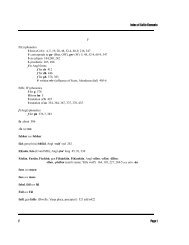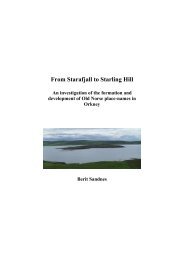May Williamson: The Non-Celtic Place-Names of the Scottish Border ...
May Williamson: The Non-Celtic Place-Names of the Scottish Border ...
May Williamson: The Non-Celtic Place-Names of the Scottish Border ...
Create successful ePaper yourself
Turn your PDF publications into a flip-book with our unique Google optimized e-Paper software.
3<br />
flumen Tesgeta tendens in meridiem inter montana” (Bk II, Chap 5: Colgrave 90). It was on<br />
this expedition that he visited Hruringaham, which must <strong>the</strong>refore lie somewhere in <strong>the</strong><br />
Cheviot Hills. Risingham is some distance south <strong>of</strong> <strong>the</strong> Teviot, but it is on <strong>the</strong> Roman Road<br />
which was <strong>the</strong> main line <strong>of</strong> communication through <strong>the</strong> Cheviots and which must have<br />
afforded <strong>the</strong> only possible route to Jarrow from Teviotdale. At Bellingham Nb, about four<br />
miles from Risingham is a road known as Cuddy’s Yett (Vernon, 371) which points to a<br />
tradition, if nothing more, that Cuthbert frequented that district.<br />
Risingham shows little resemblance to Hruringaham, but <strong>the</strong>re are no known early forms for<br />
Risingham to compare. In <strong>the</strong> script <strong>of</strong> <strong>the</strong> 10 th to 12 th centuries, Hrur- might easily have been<br />
miscopied as Hris; or an original Hris- (from OE hris “brushwood”) mistranscribed as Hrur-.<br />
Long s and an elongated r might interchange.<br />
/7/ III OE -ingtun<br />
<strong>Names</strong> ending in -ingtn belong to a later period than those in -ingas and -ingahm. <strong>The</strong>re is<br />
no trace, in <strong>the</strong> <strong>Scottish</strong> area, <strong>of</strong> a genitive plural ending between -ing and -tn. <strong>The</strong> base <strong>of</strong><br />
most <strong>of</strong> <strong>the</strong>se formations is an OE personal name. <strong>The</strong> sense <strong>of</strong> -ing may be simply genitival<br />
or possessive.<br />
BERWICKSHIRE<br />
EDINGTON (Chrn): (75, 11 J):<br />
Hadynton, 1095 (15 th ) ESC; Hœdentun, 1095-1100 (15 th ) ib; Edingtonam (acc), 1095 (15 th )<br />
ib; -ton, 1465 HMC (Var Coll v); Edintun (P), 1165-82 LSMM; Edynton (P), 1182 (1434)<br />
Cdstr, 1296 CDS. <strong>The</strong> first two spellings are dubious and may have been influenced by<br />
Haddington (ELth). A personal name Ead(d)a might be <strong>the</strong> base <strong>of</strong> <strong>the</strong> forms in -ing; cf<br />
Addington Bk (DEPN, 2), Addington Nth (PN Nth, 177).<br />
EDRINGTON (Mrd): (75, 13 K):<br />
Hadryngton, 1095 (15 th ) ESC: Hœdrinton, 1095-1100 (15 th ) ib; Edringtoun, 1309 RC; 1328<br />
Rot Scac; Ederington, 1330 Rot Scac. <strong>The</strong> first two spellings are to be compared to <strong>the</strong> first<br />
two above. <strong>The</strong> vowels are similar. <strong>The</strong> first element <strong>of</strong> <strong>the</strong> compound is OE dre, <strong>the</strong><br />
original name <strong>of</strong> <strong>the</strong> Whiteadder on which Edrington is /8/ situated. OE dringtn is “<strong>the</strong><br />
farm <strong>of</strong> <strong>the</strong> settlers by <strong>the</strong> Adder” or “<strong>the</strong> farm by <strong>the</strong> Adder”. A similar example <strong>of</strong> a rivername<br />
with -ingtn is Sinnington (PN YNR, 76).<br />
HASSINGTON (Eccl): (81, 7 B):<br />
Assinden, c 1200 (1434) Cdstr; Halsinton (P), 1230 CDS; c 1248 LSMM; Halsingtune, c<br />
1248 LSMM; -ton, 1248 APS; Halsigton, c 1270 (1434) Cdstr; Halsyngtoun, 1309 RC; -ton<br />
1336-7 CDS; 1406 RMS; Hawsintoun, 1516-17 RMS; Hassintoun, c 1564 Mel Reg Rec. An<br />
ONb *hals, “neck”, cognate with ON hals, in <strong>the</strong> sense <strong>of</strong> a small valley which broadens at<br />
both ends, might be <strong>the</strong> base <strong>of</strong> this formation, since Hassington Mains stands not far from<br />
such a valley. O<strong>the</strong>rwise <strong>the</strong> name must be associated with <strong>the</strong> Hælsingas who appear in<br />
“Widsið” (Malone, 153-4). It might be that members <strong>of</strong> that tribe joined in <strong>the</strong> migration to<br />
Britain, since <strong>the</strong>y were neighbours <strong>of</strong> <strong>the</strong> Angles. A descendant <strong>of</strong> one <strong>of</strong> <strong>the</strong> original settlers<br />
may have preserved <strong>the</strong> name Hælsing.




